The Easiest Gluten-Free Sourdough Starter Ever
I am so happy to share with you my method for making a super easy gluten-free sourdough starter – without any measurements, discards, or feedings.
So often people have been asking me how to make a gluten-free sourdough starter.
Since nobody in my family has any problems with gluten, we have always been using regular wheat, spelt, and einkorn.
But I hear those of you that – for whatever reason – wanted a gluten-free version.
You see, I have a super simple method for both making a sourdough starter as well as maintaining a sourdough starter. None of them require you to measure, discard, or feed anything. This method is perfect for anyone who does not want to stick to a feeding schedule or bakes only a few times a week.
I actually postponed this experiment for quite a while. But then I set out to see if my method would also work for a gluten-free sourdough starter.
And I am so happy to share the results with you!
New To Sourdough? Check out My Super Simple Sourdough Course!
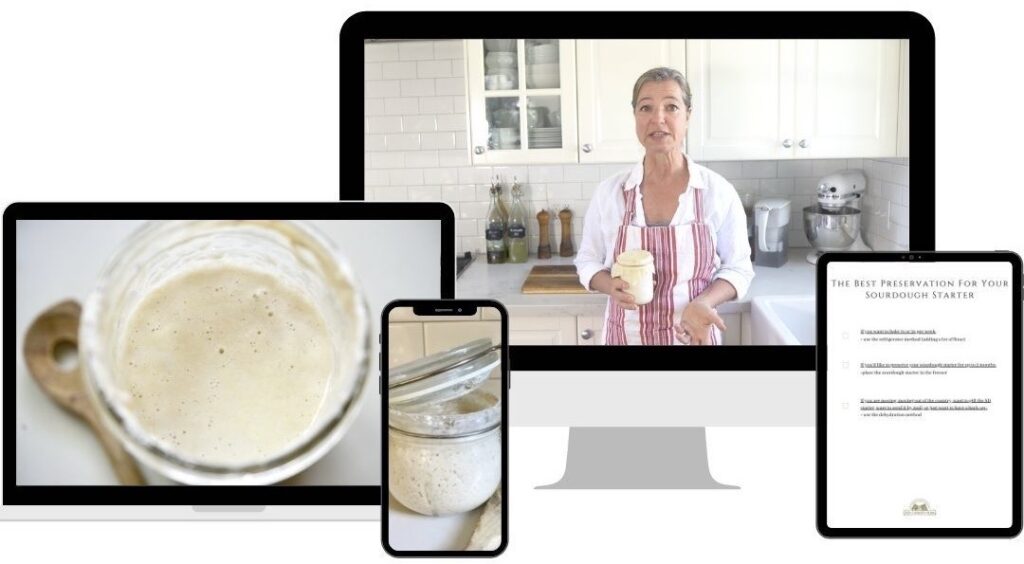
Why bake with sourdough?
People bake with sourdough mainly for these reasons:
- the fermentation process of sourdough makes the glutens in grains easier to digest for most people
- baked sourdough goods have a more complex flavor
- sourdough is the original, old-fashioned rising agent
- breads made with sourdough stay fresh longer
- you will not depend on buying yeast or baking powder
Why make a gluten-free sourdough starter?
Even though any regular sourdough makes grains easier to digest, there are many people with gluten sensitivity. Some people are diagnosed with celiac disease, meaning they cannot have any gluten at all.
For whatever, being able to make a sourdough starter without gluten is perfect for all those wanting to avoid gluten.
Now, many gluten-free grains such as buckwheat, rice, teff, and so on also become easier to digest if you bake with sourdough.
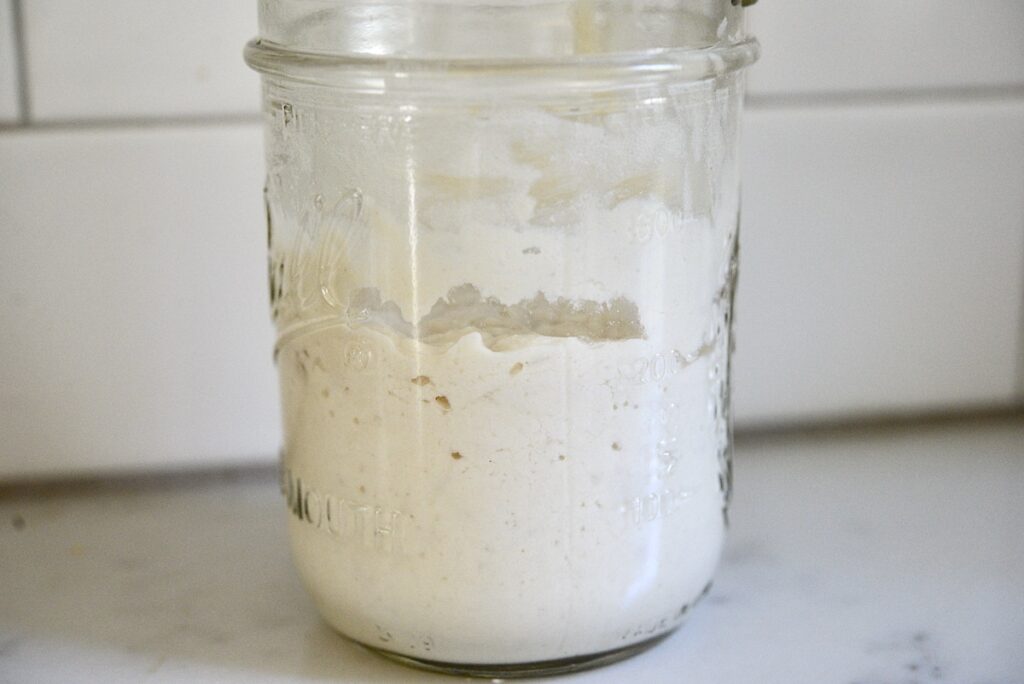
Ingredients for your gluten-free sourdough starter
This is what you need:
- A gluten-free flour: I chose Arrowhead Mills’ organic gluten-free all-purpose flour. This flour blend is perfect since it is a 1:1 replacement for regular all-purpose flour. It is a combination of different flours: organic white rice flour, organic brown rice flour, organic tapioca flour, organic millet flour, organic inulin, and xanthan gum
- Cultured buttermilk: this is my “secret” ingredient. Make sure to use buttermilk with live active cultures. You cannot use curdled ‘buttermilk’ that you get by adding lemon juice or vinegar to milk
- Glass jar: I always prefer using something like a mason jar or Weck jar. First of all, it is a non-reactive container. Secondly, you can see what is going on inside the jar.
- A wooden spoon: even though using a metal utensil for stirring will not hurt your starter, I prefer using a wooden spoon.
- A cover such as a beeswax wrap, a paper towel, a coffee filter, some fabric, and a rubber band to keep it in place
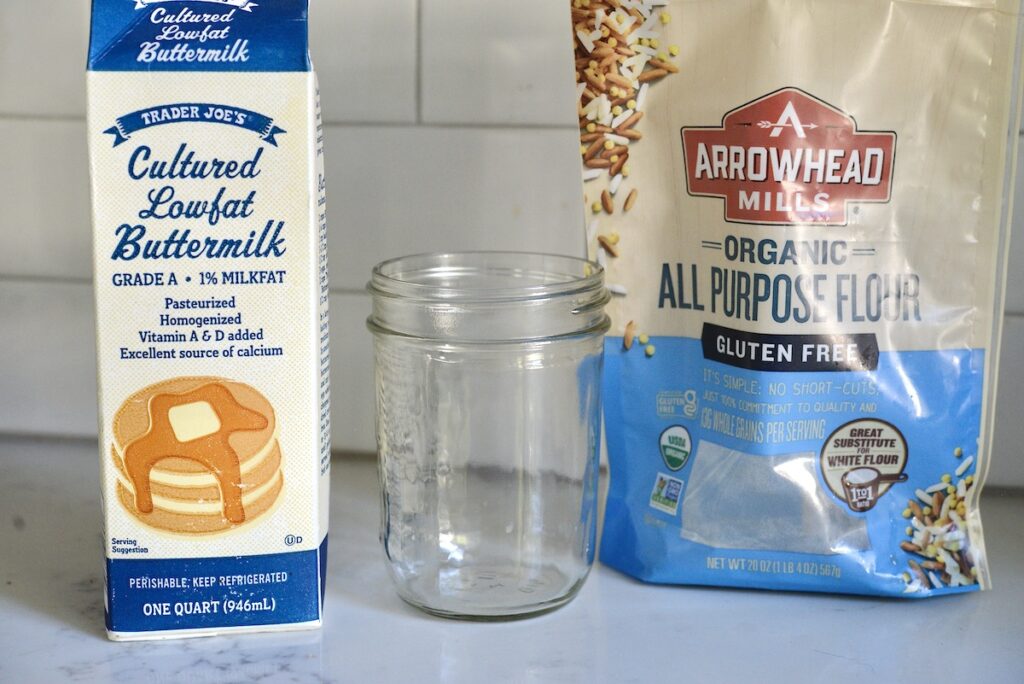
How to make your own gluten-free sourdough starter
I promised you that you would not have to measure anything. So …
- Using a 16 oz mason jar (or something similar), fill it about ⅓ or ¼ of the way with cultured buttermilk.
- Add enough gluten-free flour to create a thick pancake-batter-like consistency.
- If your starter is too thick, add some filtered water or spring water
- Give it a good stir.
- Loosely cover it with a beeswax wrap, a paper towel, plastic wrap, or some fabric.
- Set it in a warm place but room temperature is great
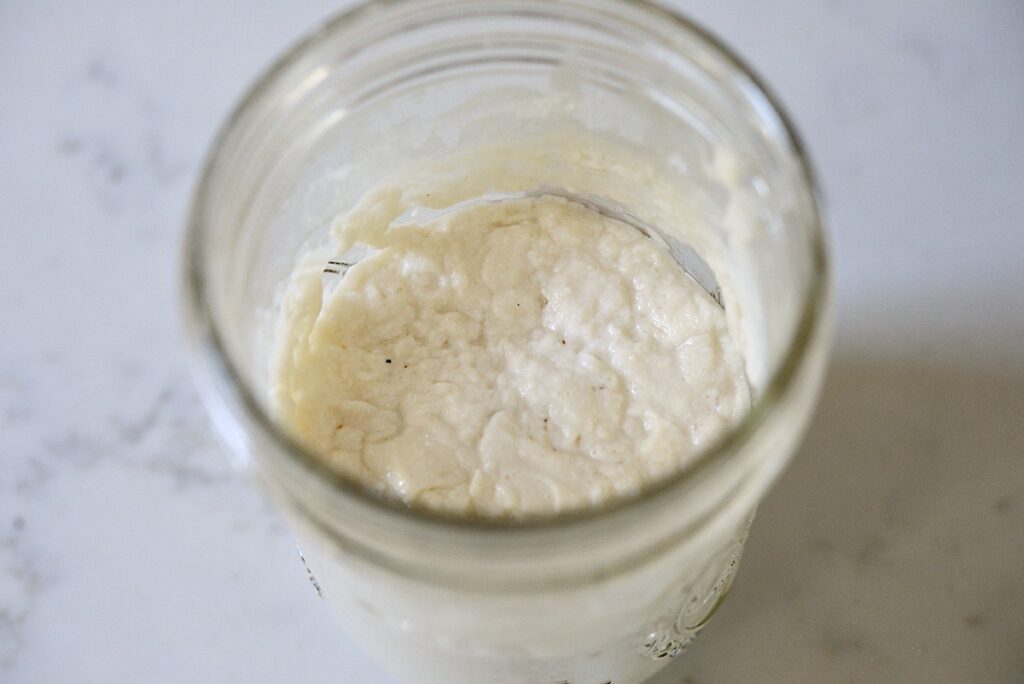
What to do next with your gluten-free sourdough starter
Every day or every other day, I like to check on my starter.
I simply look at it and give it a good stir. Depending on the temperature, you may not see much in the first few days. After 4 or 5 days, you may see some bubbles forming. You may also notice a more sour smell. These are all good signs. Just continue inspecting and stirring it every day or every couple of days.
How to know when your gluten-free sourdough starter is ripe
There are so many factors that will influence any sourdough starter, that it is challenging to give you a time frame. However, you can expect an active starter in 5-10 days. You will know it is ripe when:
- you see a lot of small bubbles throughout your sourdough starter
- it smells pleasantly sour
- it tastes pleasantly sour and has a fizzy quality
- you will hear a hollow sound when you tap your container on the bottom
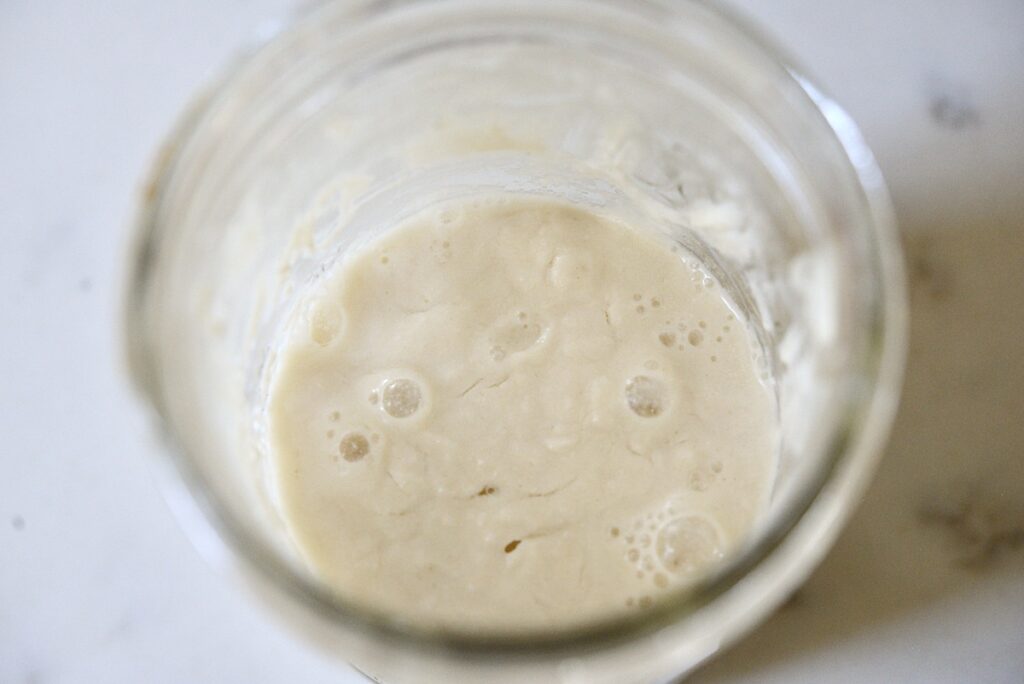
What to do next
You can now bake with your GF sourdough starter. It will be perfect for making pancakes, waffles, shortbreads, baking gluten-free bread, or making muffins or scones. I have a recipe card for basic GF scones below!
If you don’t want to make a new starter every time you bake, this no-discard, no-feeding method will be perfect for keeping your starter going.
Problems and Troubleshooting
Here are some common issues and problems
- Mold: make sure to only use filtered, distilled, or spring water. Often, tap water contains chlorine which can kill the beneficial yeasts and bacteria you are trying to cultivate. Also, make sure you keep your SD starter away from other ferments such as sauerkraut, and from anything moldy in your kitchen (even a tiny bit of mold on fruits!). I actually have an entire blog post about all the reasons why you might get mold on your sourdough starter.
- Starter not ripening: while I have successfully made sourdough starters in cool kitchens in the winter, it might just take a bit longer. However, it will be easiest if you can find a warm area for it. Also, be sure to use spring, filtered, or distilled water.
- Brown liquid on top of your starter: This is also called “hooch” and I often get it myself. Most often, I stir it right back in. Sometimes, if the starter is very thin, I add some more flour to it. It can be an indication that your SD starter is “hungry”.
- Off-smell: if your sourdough starter smells like alcohol or vinegar it is a sign that it is “hungry”. Simply add some more fresh flour, stir it in, and give it another day.
- Too many bubbles in the first few days: I have only had this happen when I made my gluten-free sourdough starter and used 100% buttermilk. Since then, I have diluted the buttermilk with filtered water by about 1:1.
You can read more about frequently asked questions about sourdough in this post.
New To Sourdough? Check out My Super Simple Sourdough Course!

Variations and Substitutions
- Flour: there are many great gluten-free flour mixes such as Bob’s Red Mill or King Arthur. While I have not personally experimented with other gluten-free flours such as buckwheat flour, teff flour, sorghum flour, brown rice flour, etc., I am pretty confident that this method will still get you a bubbly starter.
- Buttermilk: again, it is important that you use cultured buttermilk. However, if you can’t find or don’t have buttermilk you can also use other ferments. I have successfully made sourdough starters with yogurt, kefir, and kombucha. Just make sure to use plain varieties and nothing with added sugars or fruits.
- Water: if you only have tap water available, you can vigorously boil it for a few minutes and then let it cool to room temperature before using it. The chlorine will likely dissipate if you let tap water sit in an open container for 24-48 hours.
How to bake with a gluten-free starter
If you have been using gluten-free flours for your recipes, you can also use your gluten-free starter for many sourdough recipes. I don’t have too much experience baking with gluten-free flours but I know that they behave a bit differently than regular flours.
Nonetheless, I think that you can convert most sourdough recipes straight into gluten-free sourdough recipes. Look at these beautiful gluten-free sourdough blueberry muffins:
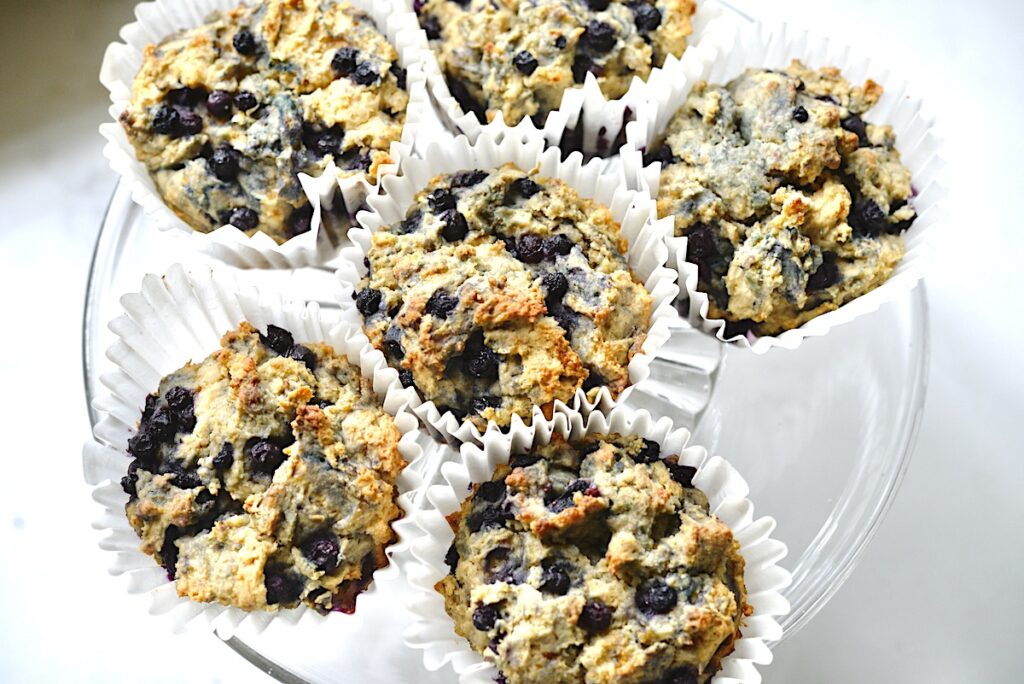
Basic Gluten-Free Sourdough Scones Recipe:
1 ½ c gluten-free flour
3 TBSP sugar
1 heap. tsp baking powder
½ tsp salt
5 TBSP butter
1 c GF sourdough starter.
Mix the dry ingredients.
Add the wet ingredients and mix everything into a uniform dough (I used my Kitchenaid stand mixer for that).
With your hands shape the dough into a flat disk on a cookie tray lined with parchment paper. Cut the dough into 6 wedges with a knife and brush it with cream.
Bake at 425˚F for 15-25 mins or until golden brown.

If you make this recipe and love it, I would love it if you gave it 5 stars! And don’t forget to tag me on Instagram @ourgabledhome with your beautiful photos!
Gluten-Free Sourdough Starter
Ingredients
- ¼ cup cultured buttermilk
- ¼ cup gluten-free AP flour (such as Arrowhead Mills)
- filtered water
Instructions
- Add some cultured buttermilk to a non-reactive container such as a 16 oz mason jar.
- Add some GF all-purpose flour.
- Mix the ingredients well.
- Add some filtered water to create a thick pancake-batter-like consistency.
- Loosely cover with a beeswax wrap, coffee filter, paper towel, or fabric.
- Set in a warm spot.
- Every day or every other day stir this mixture.
- If brown liquid forms on top of the starter, stir well. If it is very thin, add a bit more of the GF flour and mix well.
- When the starter has formed a lot of bubbles, has a pleasant sour smell, and pleasant, fizzy taste, it is ready for baking.
Nutrition
Shop this post:
Arrowhead Mills organic gluten-free all-purpose flour
King Arthur Measure for Measure GF flour
Bob’s Red Mill Gluten-Free 1 to 1 flour
Other posts you might enjoy:
Even though most of these use a regular starter, I am pretty confident you can turn them into a gluten-free sourdough recipe:
Sourdough Carrot Cake with Maple Cream Cheese Frosting
How to Make Sourdough Crackers
Pin For Later:
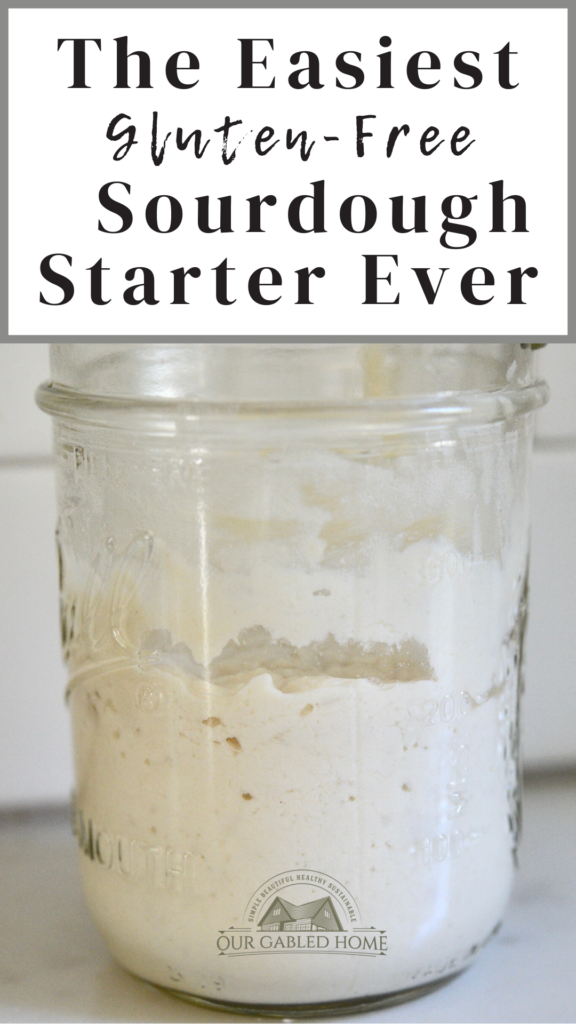
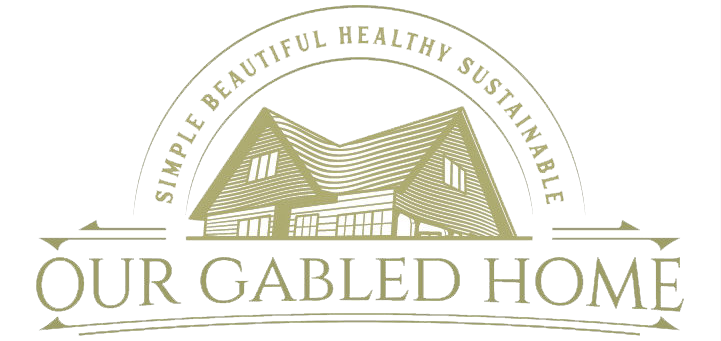

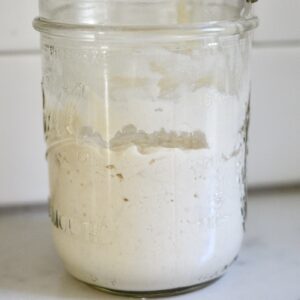
My starter is bubbly, if I want to feed it to help it grow more, do I follow the same recipe?
I would just feed it some flour and water at the same weight ~ Anja
How long should it take to bubble? I’m on day 5 and still nothing! My house is on the colder side so I do try and heat up my oven a little and stick it in there throughout the day and overnight. Anything else I can do to help it? Or just be more patient? lol
It can take about 10 days to get your first starter going. Just keep stirring and see if you can find a warmer spot ~ Anja
The whole idea of sourdough starter is for bread. You mean we can’t make bread with this?
You can bake bread with it but you need to adjust your recipe accordingly ~ Anja
Is it correct that GF sourdough starter can be left indefinitely on the counter where as regular starter has to be refrigerated ?
I have never heard that before ~ Anja
Have you used this recipe for pizza crust? If so could you share how you did it?
I haven’t but it should work well, especially if you add a bit of commercial yeast or baking powder ~ Anja
Hi Anja,
I’m a new to gluten free and am happy to see the starter recipe. Would you happen to have the recipe for the sourdough bread yet! I love your YouTube channel by the way.
I don’t have a GF sourdough bread yet but working on it. Stay tuned ~ Anja
Can I use your regular sourdough bread recipe with gluten free flour?
I don’t think that will work since you need the gluten from regular flour. However you could try to use GF flour and bake the bread in a loaf pan ~ Anja
Im new to all this making Sour dough bread I am creating the starter thanks for the recipe now what is the recipe for making gluten free bread?
Nice! I don’t have a GF bread recipe yet but it’s on my list to make ~ Anja
Hi! Howling can we keep this starter? How do we keep it alive long-term?
You should be able to keep it for as long as you like. Here’s how to keep it going: https://ourgabledhome.com/easy-sourdough-starter-no-feedings-no-discards/ Happy sourdoughing ~ Anja
How exciting! I was under the impression this wasn’t even possible! No feeding?! This is probably the recipe for me… I need low maintenance lol.
That seems really easy! I haven’t done gluten free sourdough before but this may be my next experiment.
Nice and thank you for commenting ~ Anja
Ohhh I can’t wait to try this!! My husband is gluten intolerant and will love this!
Great! Happy baking ~ Anja
What a great idea to add cultured buttermilk! And your scone recipe looks delicious. I will be trying this!
Yay! I am so glad you like these recipes ~ Anja